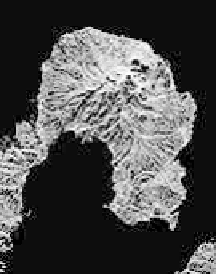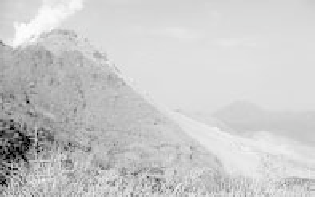Geoscience Reference
In-Depth Information
the surface, where the huge pressure gradients between
bubbles, magma, and atmosphere triggers a rolling explo-
sive
fragmentation front
with violent ejection of incandes-
cent
pumice
, ambient rock, and gases in a
free jet
. This is the
familiar “shaken-champagne bottle” analog for explosive
eruption. The skeletal walls of pumice matrix may continue
to exsolve gases in the vertical blast column, causing the
more-or-less circular bubble voids to grow even larger until
limited by framework cooling or volatile exhaustion.
Explosive events may also result after expulsion or frag-
mentation of solidified magma that blocks a vent, most
famously at Mt St Pierre (1906) and Montserrat (1995,
ongoing) in the Antilles volcanic arc. In the closely studied
Montserrat example, cyclic behavior was evident.
Degassing and crystallizing magma, evidenced by high-
level precursor seismic activity, caused vent blockage with
visco-plastic domes (viscosity
c
.10
14
Pa s) forming in the
upper conduit and the whole volcano undergoing tumes-
cence. Renewed magma ascent from a storage zone at
c
.5 km depth caused internal pressure in the rising, froth-
ing magma stream (viscosity
c
.10
6
Pa s) below the plug to
reach a critical point a few days later, causing partial ejec-
tion of the conduit-blocking plugs and violent explosive
eruptions with Vulcanian columns and pyroclastic density
flows (see below). There is evidence that partial dome col-
lapse under magma pressure may be significantly triggered
by the decrepitating effects of intense tropical rainfall on
the hot dome surface (Fig. 5.33). Once degassed, vent
activity wanes, and the eruption cycle begins over again as
another lava dome gradually constructs in the vent. The
lava dome of Unzen volcano, Japan (Fig. 5.34) collapsed
frequently due to toppling failure over a 4-year period as it
extruded onto a steep preexisting volcanic slope.
Continued or intermittent Vulcanian/Plinian blasts are
accompanied by the development of downward gravita-
tional streaming of denser, hot pumice-rich suspensions at
their outer edges (Fig. 5.33). Once descended, these form
arcuate incandescent
pyroclastic density flows
(PDFs).
These may also form without the aid of column collapse as
frothing magma “boils over” the conduit rim, like care-
fully controlled emission of champagne from a bottle. In
either case, such flows, originally termed
nuees ardentes
(glowing clouds), then travel outward as ground hugging,
high-velocity wall jets (see Fig. 1.10), denser examples
often following topographic lows like river valleys but the
more energetic and dilute, perhaps driven by turbulent
kinetic energy as in turbidity currents, capable of sur-
mounting serious topography. The PDFs are sustained ini-
tially by the initial downward vertical momentum flux,
then by a combination of furious intergranular contacts
and continued emission of volcanic gases, which may
reduce intergranular friction by fluidizing the granular
flows. The exact balance between the last two mechanisms
is not well known, particularly the reason behind the low-
friction coefficient and mobility enhancement of granular
contacts. Flow-top escape of gases and steam attest to
Mt Fugen (1359 m)
Lava dome at Mt Fugen
periodically collapses
downslope, generating
pyroclastic flows
Mt. Fugen
Mayuyama
East flank to show pale traces of pyroclastic
flow deposits feeding lahars down the
Mizunashi valley. Note arcuate scar of
Mayuyama marking flank collapse of 1792
Fig. 5.34
Unzen volcano, Japan; a dacite dome fringed by pyroclastic deposits. It grew on a steep preexisting cone flank and frequently
collapsed between 1991 and 1999. Thousands of pyroclastic flows and lahars were logged during this time.
Mizunashi valley
















Search WWH ::

Custom Search